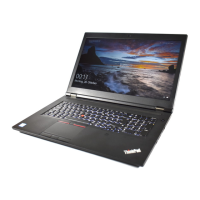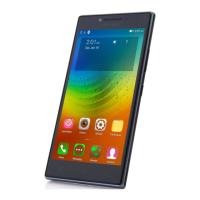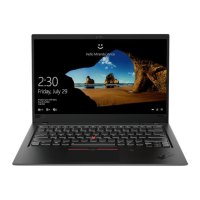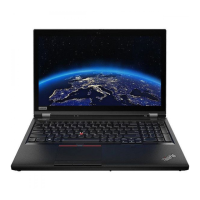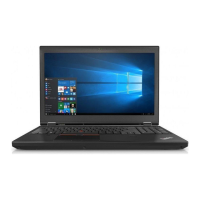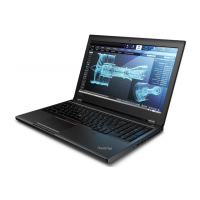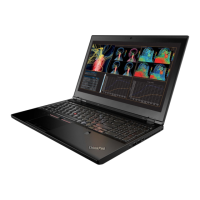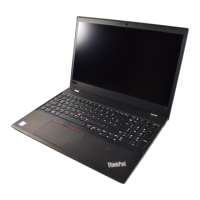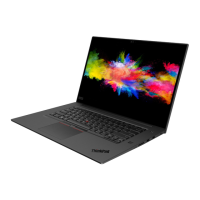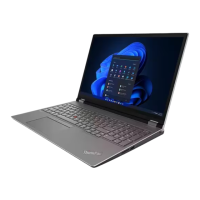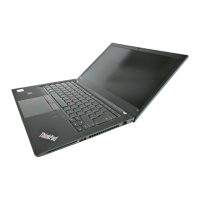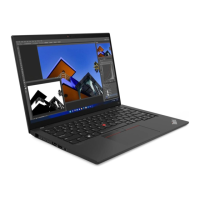Do you have a question about the Lenovo ThinkPad P72 and is the answer not in the manual?
Rules for safe operation and handling of equipment, including lifting and personal safety.
Precautions to observe when working with electrical equipment to prevent shock.
A checklist to identify potentially unsafe conditions before servicing.
Procedures for protecting sensitive electronic components from electrostatic discharge.
Importance of proper electrical grounding for operator safety and system function.
Guidelines and strategies for replacing Field Replaceable Units (FRUs).
Procedures for replacing storage drives, including data backup.
Critical considerations before replacing a system board.
How to interpret and use error codes for troubleshooting.
Information on model types and identifying FRUs.
Steps to take before and when performing a checkout.
Procedures for identifying and correcting computer problems.
Troubleshooting using Lenovo Vantage on Windows 10.
Information on quick, UEFI, and bootable diagnostic tools.
Steps to verify the functionality of power adapters and batteries.
Procedures for system recovery and advanced startup.
Details on power-on, hard disk, and supervisor passwords.
Explains sleep and hibernation modes.
Guide to diagnose problems by symptoms and identify FRUs.
Lists numeric error codes and their resolutions.
Lists common error messages and their solutions.
Troubleshooting based on beep codes and no-beep symptoms.
Diagnosing LCD issues and intermittent system problems.
Overview of RAID for storage enhancement and reliability.
Specifications for drives used in RAID configurations.
Step-by-step guide to configure RAID using Intel RST.
Instructions for creating, deleting, and resetting RAID volumes.
Explains numeric keypad, Windows key, and Fn key features.
Lists useful Fn key and other key combinations.
Identifies physical controls, ports, and status lights on the computer.
Visual guides to external component locations.
Locations of bottom ports and explanation of status lights.
Guide to finding Field Replaceable Units and Customer Replaceable Units.
Explains customer responsibility for CRUs.
Proper use and tightening of screws for reliability.
Essential rules for safely removing and replacing parts.
List of tools required for servicing the computer.
Preparatory steps before starting hardware maintenance.
Procedure to safely disable the internal battery.
Steps to remove the bottom cover for access.
Instructions for handling and replacing the battery pack.
Steps for removing the 2.5-inch storage drive.
Procedures for removing the M.2 SSD.
Steps to remove memory modules under the bottom cover.
Detailed instructions for removing the keyboard assembly.
Procedures for removing the coin-cell battery.
Steps to remove and replace the wireless LAN card.
Instructions for removing the keyboard bezel.
Procedures for removing several small components.
Steps to remove the speaker assembly.
Procedures for removing hinge caps and the LCD unit.
Steps to remove the main chassis assembly.
Instructions for removing left/right I/O boards and cables.
Procedures for removing the smart card reader.
Steps to remove and replace the thermal fan assembly.
Instructions for removing the system board and related components.
Steps for removing LCD strip cover and bezel.
Procedures for removing the LED card.
Instructions for removing the LCD panel and cable.
Procedures for removing camera and LED/camera cable assemblies.
Steps for removing antenna kit and LCD rear cover.
Disclaimer, warranty, and usage information.
Information on emissions compliance and product trademarks.
Rules for safe operation and handling of equipment, including lifting and personal safety.
Precautions to observe when working with electrical equipment to prevent shock.
A checklist to identify potentially unsafe conditions before servicing.
Procedures for protecting sensitive electronic components from electrostatic discharge.
Importance of proper electrical grounding for operator safety and system function.
Guidelines and strategies for replacing Field Replaceable Units (FRUs).
Procedures for replacing storage drives, including data backup.
Critical considerations before replacing a system board.
How to interpret and use error codes for troubleshooting.
Information on model types and identifying FRUs.
Steps to take before and when performing a checkout.
Procedures for identifying and correcting computer problems.
Troubleshooting using Lenovo Vantage on Windows 10.
Information on quick, UEFI, and bootable diagnostic tools.
Steps to verify the functionality of power adapters and batteries.
Procedures for system recovery and advanced startup.
Details on power-on, hard disk, and supervisor passwords.
Explains sleep and hibernation modes.
Guide to diagnose problems by symptoms and identify FRUs.
Lists numeric error codes and their resolutions.
Lists common error messages and their solutions.
Troubleshooting based on beep codes and no-beep symptoms.
Diagnosing LCD issues and intermittent system problems.
Overview of RAID for storage enhancement and reliability.
Specifications for drives used in RAID configurations.
Step-by-step guide to configure RAID using Intel RST.
Instructions for creating, deleting, and resetting RAID volumes.
Explains numeric keypad, Windows key, and Fn key features.
Lists useful Fn key and other key combinations.
Identifies physical controls, ports, and status lights on the computer.
Visual guides to external component locations.
Locations of bottom ports and explanation of status lights.
Guide to finding Field Replaceable Units and Customer Replaceable Units.
Explains customer responsibility for CRUs.
Proper use and tightening of screws for reliability.
Essential rules for safely removing and replacing parts.
List of tools required for servicing the computer.
Preparatory steps before starting hardware maintenance.
Procedure to safely disable the internal battery.
Steps to remove the bottom cover for access.
Instructions for handling and replacing the battery pack.
Steps for removing the 2.5-inch storage drive.
Procedures for removing the M.2 SSD.
Steps to remove memory modules under the bottom cover.
Detailed instructions for removing the keyboard assembly.
Procedures for removing the coin-cell battery.
Steps to remove and replace the wireless LAN card.
Instructions for removing the keyboard bezel.
Procedures for removing several small components.
Steps to remove the speaker assembly.
Procedures for removing hinge caps and the LCD unit.
Steps to remove the main chassis assembly.
Instructions for removing left/right I/O boards and cables.
Procedures for removing the smart card reader.
Steps to remove and replace the thermal fan assembly.
Instructions for removing the system board and related components.
Steps for removing LCD strip cover and bezel.
Procedures for removing the LED card.
Instructions for removing the LCD panel and cable.
Procedures for removing camera and LED/camera cable assemblies.
Steps for removing antenna kit and LCD rear cover.
Disclaimer, warranty, and usage information.
Information on emissions compliance and product trademarks.
| Bus type | DMI |
|---|---|
| Stepping | U0 |
| Tjunction | 100 °C |
| Processor cache | 9 MB |
| Processor cores | 6 |
| Processor model | i7-8750H |
| System bus rate | 8 GT/s |
| Processor family | Intel® Core™ i7 |
| Processor socket | BGA 1440 |
| Processor threads | 12 |
| Processor codename | Coffee Lake |
| Processor frequency | 2.2 GHz |
| Processor cache type | Smart Cache |
| Configurable TDP-down | 35 W |
| Processor lithography | 14 nm |
| Processor manufacturer | Intel |
| PCI Express slots version | 3.0 |
| Processor boost frequency | 4.1 GHz |
| Processor operating modes | 64-bit |
| ECC supported by processor | No |
| PCI Express configurations | 1x16, 1x8+2x4, 2x8 |
| Thermal Design Power (TDP) | 45 W |
| Configurable TDP-down frequency | 1.7 GHz |
| Maximum number of PCI Express lanes | 16 |
| Maximum resolution | 5120 x 2880 pixels |
| On-board graphics card | Yes |
| On-board graphics card ID | 0x3E9B |
| Discrete graphics card model | NVIDIA® Quadro® P2000 |
| On-board graphics card model | Intel® UHD Graphics 630 |
| Discrete graphics card memory | 4 GB |
| On-board graphics card family | Intel® UHD Graphics |
| Maximum on-board graphics card memory | 64 GB |
| On-board graphics card OpenGL version | 4.5 |
| On-board graphics card base frequency | 350 MHz |
| On-board graphics card DirectX version | 12.0 |
| Number of discrete graphics cards supported | 1 |
| On-board graphics card dynamic frequency (max) | 1100 MHz |
| Motherboard chipset | Intel® CM246 |
| Memory slots | 4x SO-DIMM |
| Internal memory | 8 GB |
| Memory clock speed | 2400 MHz |
| Memory form factor | SO-DIMM |
| Internal memory type | DDR4-SDRAM |
| Maximum internal memory | 128 GB |
| Memory layout (slots x size) | 1 x 8 GB |
| Display surface | Matt |
| Display diagonal | 17.3 \ |
| Display brightness | 300 cd/m² |
| Native aspect ratio | 16:9 |
| Second display touch technology | Multi-touch |
| HDD size | 2.5 \ |
| HDD speed | 7200 RPM |
| SSD capacity | The Solid State Drive's storage capacity in Gigabytes. |
| HDD interface | SATA III |
| SSD interface | NVMe, PCI Express |
| Storage media | HDD+SSD |
| SSD form factor | M.2 |
| Total HDDs capacity | 1000 GB |
| Total SSDs capacity | 256 GB |
| Total storage capacity | 1256 GB |
| Compatible memory cards | MMC, SD, SDHC, SDXC |
| MIMO type | Multi User MIMO |
| Antenna type | 2x2 |
| Wi-Fi standards | 802.11a, Wi-Fi 5 (802.11ac), 802.11b, 802.11g, Wi-Fi 4 (802.11n) |
| Bluetooth version | 5.0 |
| Top Wi-Fi standard | Wi-Fi 5 (802.11ac) |
| WLAN controller model | Intel Dual Band Wireless-AC 9560 |
| Wi-Fi data rate (max) | 1733 Mbit/s |
| Ethernet LAN data rates | 10, 100, 1000 Mbit/s |
| Charging port type | - |
| USB 2.0 ports quantity | USB 2.0 ports have a data transmission speed of 480 Mbps, and are backwards compatible with USB 1.1 ports. You can connect all kinds of peripheral devices to them. |
| Thunderbolt 3 ports quantity | 2 |
| USB 3.2 Gen 1 (3.1 Gen 1) Type-A ports quantity | 4 |
| USB 3.2 Gen 1 (3.1 Gen 1) Type-C ports quantity | 0 |
| Front camera HD type | HD |
| Front camera resolution | 1280 x 720 pixels |
| Front camera signal format | 720p |
| Pointing device | ThinkPad UltraNav |
| Cable lock slot type | Kensington |
| Password protection type | HDD, Power on, Supervisor |
| Battery capacity | 99 Wh |
| Battery life (max) | 18 h |
| Fast charging time (90%) | 60 min |
| AC adapter power | 230 W |
| AC adapter frequency | 50 - 60 Hz |
| AC adapter input voltage | 100 - 240 V |
| DisplayPort version | 1.4 |
| Memory upgrade note | Additional memory sold separately |
| Form factor | Clamshell |
| Product type | Mobile workstation |
| Product color | Black |
| Market positioning | Business |
| Audio chip | Realtek ALC3286 |
| Audio system | Dolby Audio Premium |
| Speaker power | 2 W |
| Sustainability certificates | RoHS, EPEAT Gold, ENERGY STAR |
| Certification | MIL-STD-810G |
| Processor code | SR3YY |
| Processor ARK ID | 134906 |
| Processor package size | 42 x 28 mm |
| Supported instruction sets | AVX 2.0, SSE4.1, SSE4.2 |
| Intel Identity Protection Technology version | 1.00 |
| Intel Stable Image Platform Program (SIPP) version | 0.00 |
| Depth | 281 mm |
|---|---|
| Width | 416 mm |
| Weight | 3400 g |
| Height (rear) | 29.4 mm |
| Height (front) | 24.5 mm |
